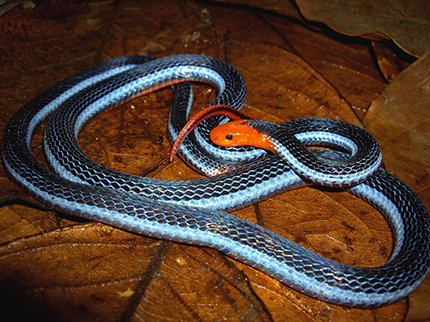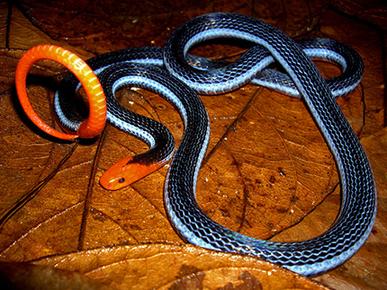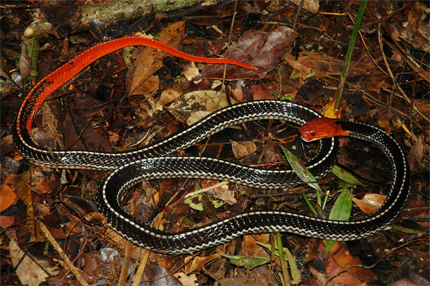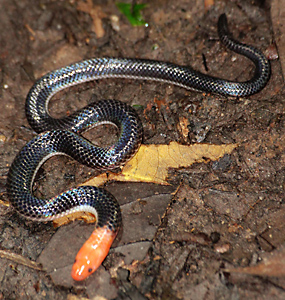Table of Contents
Description
The Malayan Blue Coral Snake is a slender, medium-sized snake. A full-grown adult can reach a length of just under 2 metres. The tail is short and composes only 10% of the total length of the snake, and ends in a sharp point. The head is relatively small and not wider than the neck. The dorsal surface is blue-black and a pair of sky-blue stripes run along each side of the body. The head, ventral surface and entire tail are red in colour (Stuebing et al., 1999).
The number of ventral scales varies between 243-304, and subcaudal scales between 37-49. Preocular scales are present and the anal scute is single and undivided.
This species possess rigid hollow fangs in the anterior part of the upper jaw. This is a defining characteristic of all snakes in the family Elapidae (Collective, 2011).
Owing to the elusive nature of the Malayan Blue Coral Snake, there is a paucity of scientific data and research done on it as compared to other more conspicuous and well-studied snake species.
|
|
 |
| Anal scutes. The image on the right shows the Calliophis bivirgatus. Adapted from Leviton et al., 2003 (pending permission) |
Diagnosis
The Malayan Blue Coral Snake is often confused with other snake species such as the Red-Headed Krait (Bungarus flaviceps) and the Pink-Headed Reed Snake (Calamaria schlegeli). The Red-Headed Krait is venomous while the Pink-Headed Reed Snake is non-venomous (Lim & Lee, 1989). Nevertheless, if in doubt, treat all snake species as venomous.
A key characteristic that differentiates these species is the colour of their ventral surfaces. The Malayan Blue Coral Snake is coloured red along its entire ventral surface whereas in the Red-Headed Krait, only the ventral surfaces of the head and tail regions are coloured red, while the ventral surface of the rest of the body is coloured black. The Pink-Headed Reed Snake is coloured greyish-white on the ventral surface of its entire body.
Another distinguising feature is the pair of blue stripes that are only found on the Malayan Blue Coral Snake.
| Note: These are not the Malayan Blue Coral Snake |
|||||
|
|
||||
Glossary
Distribution and Habitat
This species is distributed throughout southern Thailand, Cambodia, Malaysia, Singapore and western Indonesia (Stuebing et al., 1999). The subspecies Calliophis bivirgatus tetrataenia is restricted to Borneo, while Calliophis bivirgatus bivirgata is restricted to Java and Calliophis bivirgatus flaviceps is found throughout the shaded area in the figure shown below except on Java.
It mainly inhabits lowland primary forests but can also be found in mature secondary forests below 700 metres in elevation. Despite its conspicuous colouration, this species is relatively secretive and often hides among the leaf litter of the forest floor.
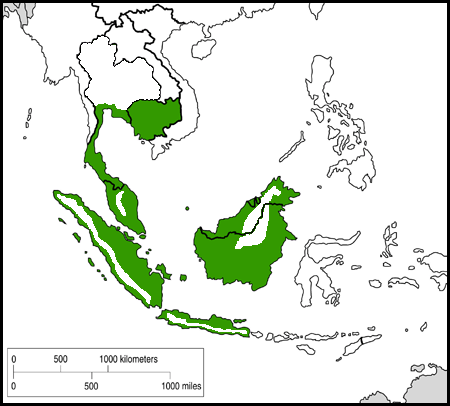 |
| Native range of the Malayan Blue Coral Snake in Southeast Asia is depicted by the areas shaded in green. |
Singapore
In Singapore, Calliophis bivirgatus flaviceps is the only subspecies present. It can be found in the Bukit Timah Nature Reserve, Central Catchment Nature Reserve and the Western Catchment Area.Biology
Feeding Habits
The diet comprises mainly of other snakes, including smaller members of its own species. It also feeds on lizards, birds and frogs occasionally. It usually feeds at night when it is most active.| Video of a Malayan Blue Coral Snake feeding on a reed snake. |
Defense Mechanism and Venom
The Malayan Blue Coral Snake is a highly venomous front-fanged snake. In contrast to other venomous snakes, the venom glands of this species are exceptionally long, extending approximately one-third the length of the body. The venom is primarily neurotoxic in nature and the main active compounds are phospholipases and cytotoxins. In a study conducted in Thailand, dry venom yields from a single adult snake ranged from 56.63-71.40mg. Using mice as the test subjects, the LD50 of the venom was determined to be 0.81ug/g of mouse body weight (Chanhome et al., 2011).However, in actual fact, this species is relatively docile and non-aggressive. When threatened, it usually tucks its head under leaves or under its coil of body and raises its tail to reveal the bright red ventral surface. The bright red colour of the tail is also thought to make it difficult for predators to distinguish the head from the tail (Greene, 1973).
Reproduction
Not much is known about the breeding habits of this species. It produces 1-3 eggs that measure approximately 9mm x 35mm (Das, 2010).Threats to Humans and Preventive Measures
This snake can cause human fatalities and at least 2 cases were reported in Malaysia, where a young child died 2 hours after being bitten at the base of the thumb in 1956 and a man who died within 5 minutes after being bitten twice on his left toes in 1985 (Lim & Lee, 1989). It is one of the most dangerous snakes in Southeast Asia. In fact, the venom is thought to be so lethal that this species has been nicknamed the "100 paces", since no man can walk more than 100 steps after being bitten. No anti-venom is currently available.
How not to be the next victim of the Malayan Blue Coral Snake:
- Keep a safe distance from the snake, most bites occur due to provocation of the snake
- Don good quality long pants and trekking shoes when visiting the nature reserves
- Avoid trekking in the nature reserves alone
- Avoid trekking at night when this snake is most active
- Do not wander off designated hiking trails
- If in doubt of the snake's identity, treat all snake species as venomous
- If bitten, remain calm and avoid movement to slow the spread of venom. Contact the NParks emergency hotline at 1800 - 471 7300 immediately
Name
This section provides information on the original descriptions of the Malayan Blue Coral Snake. This is important as scientiic literature is always published using scientific names. A species may have several scientific names (synonyms) before one is chosen as the accepted name, hence researchers interested in collecting all available scientific data would have to take all synonyms into consideration. Common names are important too as people outside the scientific community may have valauble knowledge about a species but only recognise its common name.
Binomial: Calliophis bivirgatus BOIE 1827
The type species of the genus Calliophis is Calliophis gracilis GRAY 1835.
Subspecies: Calliophis bivirgatus bivirgata BOIE 1827, Calliophis bivirgatus flaviceps CANTOR 1839, Calliophis bivirgatus tetrataenia MALKMUS 2002
Synonyms: Adeniophis bivirgatus BOETTGER 1887, Doliophis bivirgatus BOULENGER 1896, Maticora bivirgata MANTHEY 1997
The genus Maticora was synonymised with Calliophis by Slowinski et al., (2001). This is evident in the very high bootstrap value of 99% of the branch between the Calliophis and Maticora genera in the consensus tree shown to the right. Maticora bivirgata is the only accepted synonym today.
Common Names: Malayan Blue Coral Snake, Blue Malaysian Coral Snake, Blaue Bauchdrüsenotter (German)
Taxonavigation
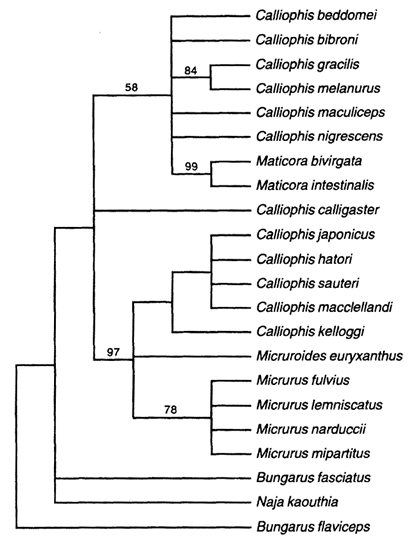 |
| Consensus tree derived from morphological data with bootstrap values shown. Adpated from Slowinski et al., 2001. (pending permission) |
- Kingdom: Animalia
- Phylum: Chordata
- Class: Reptilia
- Order: Squamata (snakes and lizards that moult periodically and possess a loosely-connected jaw)
- Family: Elapidae (venomous snakes with hollow, fixed fangs)
- Genus: Calliophis (Asian Coral Snakes)
Etymology
Etymology here refers to the origin and reasoning behind the scientific name of a species. It allows for the relevance and applicability of the species name to be known.
The species epithet bivirgatus (bi=two, virgatus=branch), refers to the pair of light blue stripes running along the sides of the snake's body (Stuebing et al., 1999).
Type and Genomic Information
This section contains the type and genomic information of this species, which are useful references for potential research work in the future.
The holotype of Calliophis bivirgatus was captured in Java, Indonesia, and is stored in the Staatliches Museum für Naturkunde Stuttgart (Stuttgart State Museum of Natural History) in Germany.
Paratype specimens
| Name of Institution |
Catalog Number |
| Louisiana State University Museum of Natural Science |
LSUMZ37496 |
| Raffles Museum of Biodiversity Research |
ZRC.2.6095 ZRC.2.3535 ZRC.2.3916 ZRC.2.3921 ZRC.2.5898 |
| California Academy of Sciences |
16778 16779 16780 |
| Museum of Comparative Zoology, Harvard University |
R-7798 |
| Australian Museum |
Herpetology:R.97022 |
| Western Australian Museum |
REPT:115881 |
GenBank Data
from Kelly et al. (2009)| Gene |
Accession Number |
| Cytochrome b |
AF217812.1 |
| NADH dehydrogenase subunit 1 |
AY058955.1 |
| NADH dehydrogenase subunit 2 |
AY059007.1 |
| NADH dehydrogenase subunit 4 |
AY058979.1 |
| Oocyte maturation factor Mos proto-oncogene |
AY058934.1 |
Literature and References
- Boie, F. (1827). Bemerkungen über Merrem’s Versuch eines Systems der Amphibien. Marburg. 1820. Erste Lieferung: Ophidier. Isis von Oken, 20(10), 508–566
- Chanhome, L., & Cox, M. J. (2011). Characterization of venomous snakes of Thailand. Asian Biomedicine (Research Reviews and News), 5(3), 311.
- Collective. (2011). Elapid Snakes. In P. K. L. Ng, R. T. Corlett & H. T. W. Tan (Eds.), Singapore Biodiversity: An Encyclopedia of the Natural Environment (pp. 302): Editions Didier Millet.
- Das, I. (2010). SNAKES OF THE PIASAU CAMP, from http://www.outpostexpat.nl/media/locations/malaysia/miri/Documents/SafetynSecurity/piasau_snake_guide.pdf
- Greene, H. W. (1973). Defensive tail display by snakes and amphisbaenians. Journal of Herpetology, 143-161.
- Kelly, C. M. R., Barker, N. P., Villet, M. H., & Broadley, D. G. (2009). Phylogeny, biogeography and classification of the snake superfamily Elapoidea: a rapid radiation in the late Eocene. Cladistics, 25(1), 38-63.
- Leviton, A. E., Wogan, G. O. U., Koo, M. S., Zug, G. R., Lucas, R. S., & Vindum, J. V. (2003). The Dangerously Venomous Snakes of Myanmar. PROCEEDINGS OF THE CALIFORNIA ACADEMY OF SCIENCES, 54(24).
- Lim, F. L. K., & Lee, M. T. M. (1989). Fascinating snakes of Southeast Asia: an introduction: Tropical Press Kuala Lumpur, 82-83
- Slowinski, J. B., Boundy, J., & Lawson, R. (2001). The phylogenetic relationships of Asian coral snakes (Elapidae: Calliophis and Maticora) based on morphological and molecular characters. Herpetologica, 233-245.
- Stuebing, R. B., Inger, R., Stuebing, R., & Tan, F. L. (1999). A field guide to the snakes of Borneo: Natural History Pub, 193-194
Links
Global Species: Calliophis bivirgatus (Blue Malaysian Coral Snake)
Wikipedia: Calliophis bibirgatus
The Reptile Database: Calliophis bivirgata
NParks Flora&Fauna Web: Calliophis bivirgatus
Ecology Asia: Blue Malayan Coral Snake
Atlas of Living Australia: Blue Malaysian Coral Snake
Global Biodiversity Information Facility: Calliophis bivirgatus
